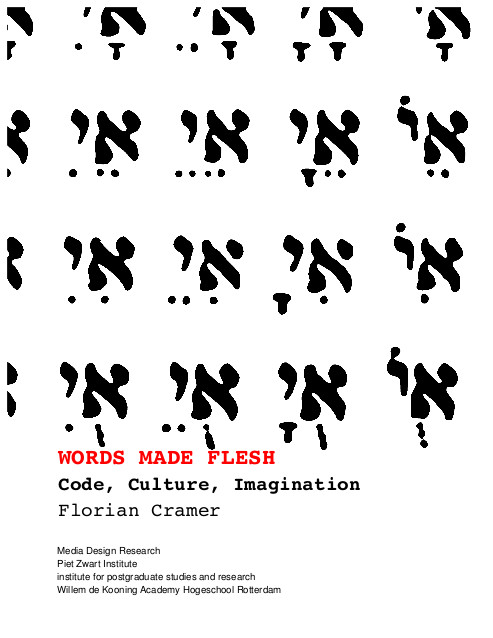Casey Reas, Ben Fry: Processing: A Programming Handbook for Visual Designers and Artists (2007)
Filed under manual | Tags: · art, code, computer animation, computer art, design, image, interactivity, open source, performance, processing, programming, software, typography

It has been more than twenty years since desktop publishing reinvented design, and it’s clear that there is a growing need for designers and artists to learn programming skills to fill the widening gap between their ideas and the capability of their purchased software. This book is an introduction to the concepts of computer programming within the context of the visual arts. It offers a comprehensive reference and text for Processing (www.processing.org), an open-source programming language that can be used by students, artists, designers, architects, researchers, and anyone who wants to program images, animation, and interactivity.
The ideas in Processing have been tested in classrooms, workshops, and arts institutions, including UCLA, Carnegie Mellon, New York University, and Harvard University. Tutorial units make up the bulk of the book and introduce the syntax and concepts of software (including variables, functions, and object-oriented programming), cover such topics as photography and drawing in relation to software, and feature many short, prototypical example programs with related images and explanations. More advanced professional projects from such domains as animation, performance, and typography are discussed in interviews with their creators. “Extensions” present concise introductions to further areas of investigation, including computer vision, sound, and electronics. Appendixes, references to other material, and a glossary contain additional technical details. Processing can be used by reading each unit in order, or by following each category from the beginning of the book to the end. The Processing software and all of the code presented can be downloaded and run for future exploration.
Essays by: Alexander R. Galloway, Golan Levin, R. Luke DuBois, Simon Greenwold, Francis Li, Hernando Barragán
Interviews with: Jared Tarbell, Martin Wattenberg, James Paterson, Erik van Blockland, Ed Burton, Josh On, Jürg Lehni, Auriea Harvey and Michaël Samyn, Mathew Cullen and Grady Hall, Bob Sabiston, Jennifer Steinkamp, Ruth Jarman and Joseph Gerhardt, Sue Costabile, Chris Csikszentmihályi, Golan Levin and Zachary Lieberman, Mark Hansen
Foreword by John Maeda
Publisher MIT Press, 2007
ISBN 0262182629, 9780262182621
Length 710 pages
project website
publisher
google books
PDF
All code examples in the book (ZIP)
Radical Software (1970-1974)
Filed under magazine | Tags: · art, computer art, electromagnetism, software, technology, television, video, video art
The historic video magazine Radical Software was started by Beryl Korot, Phyllis Gershuny, and Ira Schneider and first appeared in Spring of 1970, soon after low-cost portable video equipment became available to artists and other potential videomakers. Though scholarly works on video art history often refer to Radical Software, there are few places where scholars can review its contents. Individual copies are rare, and few complete collections exist.
Radical Software was an important voice of the American video community in the early 70s; the only periodical devoted exclusively to independent video and video art at the time when those subjects were still being invented. Issues included contributions by Nam June Paik, Douglas Davis, Paul Ryan, Frank Gillette, Beryl Korot, Charles Bensinger, Ira Schneider, Ann Tyng, R. Buckminster Fuller, Gregory Bateson, Gene Youngblood, Parry Teasdale, Ant Farm, and many others.
Eleven issues of Radical Software were published from 1970 to 1974, first by the Raindance Corporation and then by the Raindance Foundation with Gordon and Breach Publishers.

Radical Software, Volume I, Number 1
The Alternate Television Movement,
Spring 1970
PDF

Radical Software, Volume I, Number 2
The Electromagnetic Spectrum,
Autumn 1970
PDF

Radical Software, Volume I, Number 3
Untitled, Spring 1971
PDF

Radical Software, Volume I, Number 4
Untitled, Summer 1971
PDF

Radical Software, Volume I, Number 5
Realistic Hope Foundation,
Spring 1972
PDF

Radical Software, Volume II, Number 1
Changing Channels, Winter 1972
PDF

Radical Software, Volume II, Number 2
The TV Environment, Spring 1973
PDF

Radical Software, Volume II, Number 3
Videocity, Summer 1973
PDF

Radical Software, Volume II, Number 4
Solid State, Autumn 1973
PDF

Radical Software, Volume II, Number 5
Video and Environment, Winter 1973
PDF

Radical Software, Volume II, Number 6
Video and Kids, Summer 1974
PDF
Florian Cramer: Words Made Flesh: Code, Culture, Imagination (2005)
Filed under book | Tags: · art, art history, code, code poetry, computation, experimental literature, kabbalah, language, literature, philosophy, poetry, religion, software, software art, technology

“Executable code existed centuries before the invention of the computer in magic, Kabbalah, musical composition and experimental poetry. These practices are often neglected as a historical pretext of contemporary software culture and electronic arts. Above all, they link computations to a vast speculative imagination that encompasses art, language, technology, philosophy and religion. These speculations in turn inscribe themselves into the technology. Since even the most simple formalism requires symbols with which it can be expressed, and symbols have cultural connotations, any code is loaded with meaning. This booklet writes a small cultural history of imaginative computation, reconstructing both the obsessive persistence and contradictory mutations of the phantasm that symbols turn physical, and words are made flesh.”
Editor: Matthew Fuller, additional corrections: T. Peal
Published within Media Design Research programme, Piet Zwart Institute, Willem de Kooning Academy Hogeschool, Rotterdam
GNU General Public License 2; GNU Free Documentation License 1.2; Creative Commons Attribution-ShareAlike License 2.0
141 pages
Review: Tomáš Javůrek (Joinme, 2018, CZ).
PDF (updated on 2012-10-11)
HTML (added on 2013-7-1)
Sequel: Exe.cut(up)able statements: Poetische Kalküle und Phantasmen des selbstausführenden Texts (2011, in German).
Comment (0)
